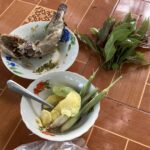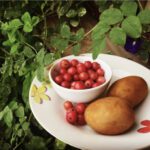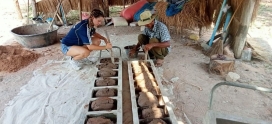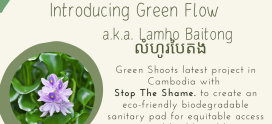Plant Planet Plate at GreenShoots
In July 2019 while at a friend’s farm in Banteay Meanchey Province Cambodia I was introduced to a Jamaican Cherry (Plai Cher Krahop)- a small pinkish-red berry without a pip growing on a tree and sweet in taste. Upon my return to Samrong that same week, I found myself noticing the tree everywhere- and had to curb to urge my need to stop on the roadside and pick a few to snack on. On that same trip an eight year old girl living next door to the AgriTech Centre introduced me to “saw maw” or wild passion fruit. Small orange gooseberry-like fruit, growing on a vine curling around most trees and structures in the Centre. These added to my curiosity about delving more into Khmer foods and ingredients and diversifying from the usual produce of aubergine, cucumbers and I beans. I kept facing roadblocks- research either lost due to civil war or only available in French.
However, I can now see this as the beginnings of what would go on to become Plant Planet Plate- a collaboration between GreenShoots and Dr. Ashley Thuthao Keng Dam who holds a PhD in Ecogastronomy, Education, and Society . While our initial connection was made in 2021, the inception of Plant Planet Plate took some time. Dr. Ashley came to us with the idea of studying plants and creating a digital library/database of plant species, their uses, cultural significance and current status in Cambodia. They had already completed something similar for Dumbarton Oaks, called the Plant Humanities Lab, and wanted to apply and integrate their doctoral research in Cambodia similarly. This resonated well with GreenShoots work so far- there was an interest in forest gardening at the AgriTech Centre and we had come across gaps in historical information about plant diversity and cultivation in Cambodia. Then in 2021, we began to see a scope for studying foraged-foods and nutrition.
Being just 40 Km from the Thai border, Green Shoots is in a location that had its own unique impacts of COVID-19. Many migrant populations returned so household sizes increased, goods in the market became costly as borders shut and Samrong has a high dependency on trade from across the border. Despite these negatives, In December 2021 our COVID-19 community study conveyed that households remained food secure (i.e. people had enough to eat) all because of the Khmer tradition of foraging and wild foods. Once again hitting home that there exists an innate knowledge of food and ingredients that might not necessarily be documented but it is shared within generations and across communities.
When we think of wild foods, at times it can feel like the product in question might be the most unusual or bizarre looking item growing in the deep forest. However, in most cases, it can be the most unassuming- a leaf that looks like all the other leaves around it but expect it is of value and exceptional taste. One example of this is the Mempat Leaf or Sour Leaf (ល្ងៀង)- which is regularly seen in Cambodia accompanying snacks, noodle dishes and even in food stalls. There are no farms for it, and neither is it traded in. It’s just growing everywhere- if one knows how to recognise it. Like the Jamaican cherry I cannot resist snacking on. Mempat Leaf is a staple at the end of a farm-day with grilled fish (preferably from a rice paddy) and sliced raw mango.
Essentially Plant Planet Plate aims to bring together the knowledge of not only how we grow, prepare and eat food but delves into the when and why certain things are grown, consumed and prepared. For us at Green Shoots, it’s an exciting layer to add at the AgriTech Centre. It can bring together efforts being made by universities, chefs and restaurants in Cambodia that are delving into the past to understand the cuisine and its agricultural heritage. In June 2023 Green Shoots & Dr. Ashley will embark on a month-long research study (an Explorer Grant for Dr. Ashley from National Geographic).
This study will research eight ingredients in depth to commence our Plant Planet Plate database, a prototype created by Dr. Ashley can be found here and a living library will be created at the Agri-Tech Centre Forest Garden!







